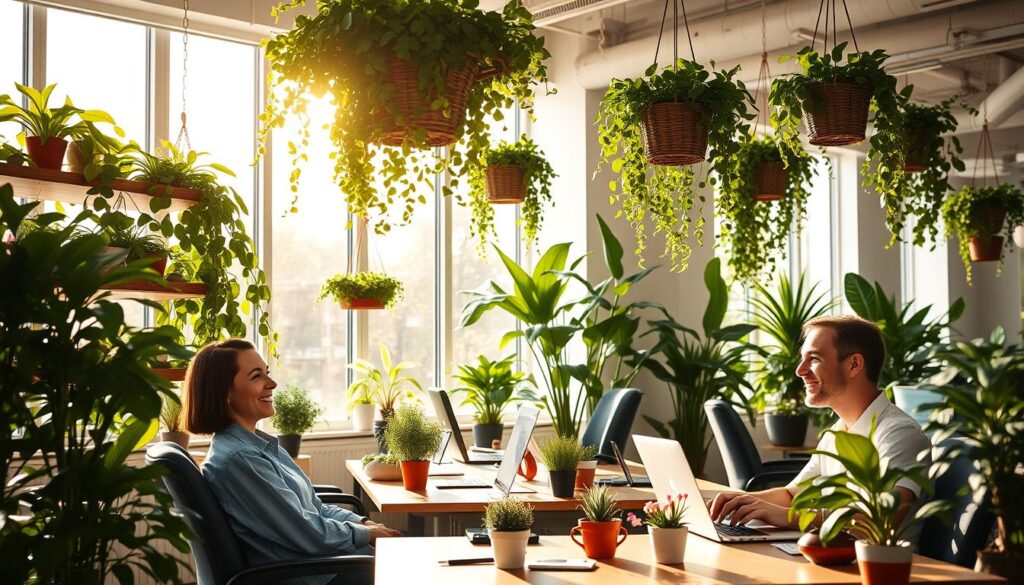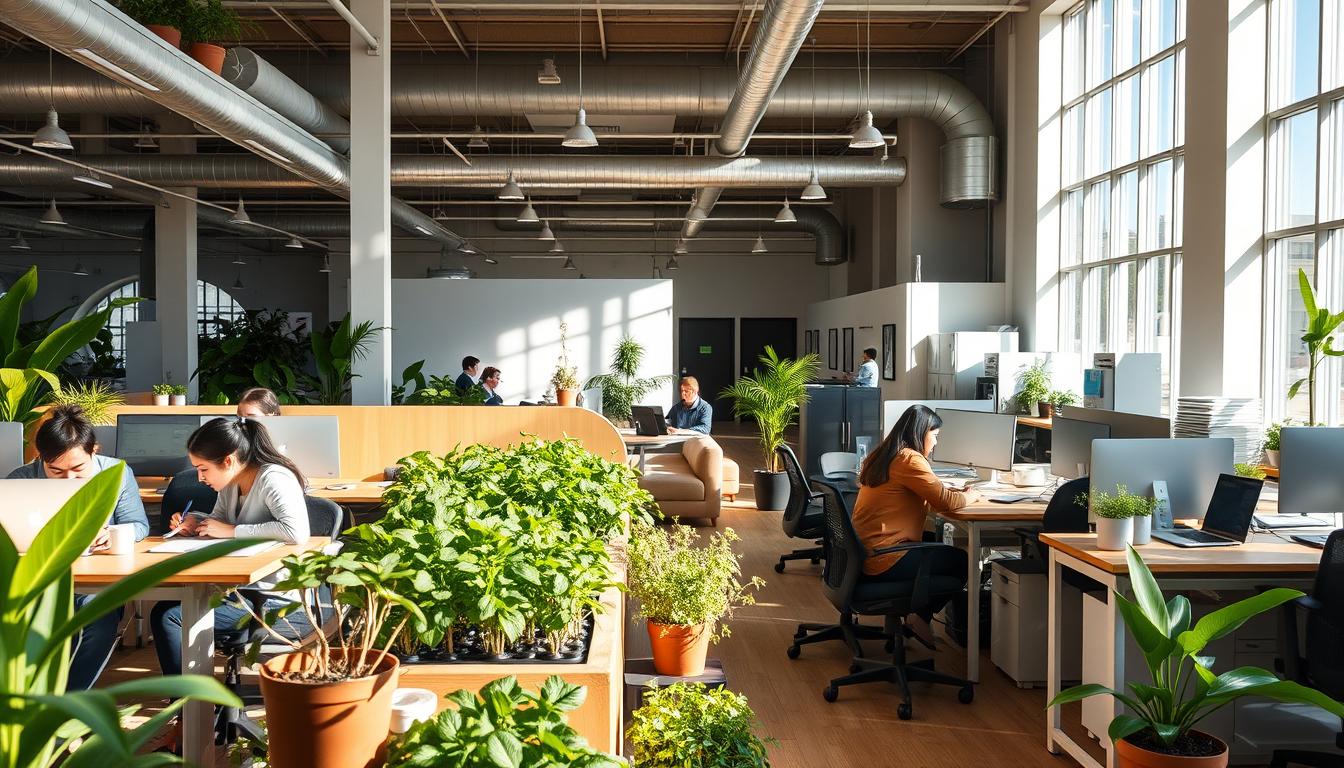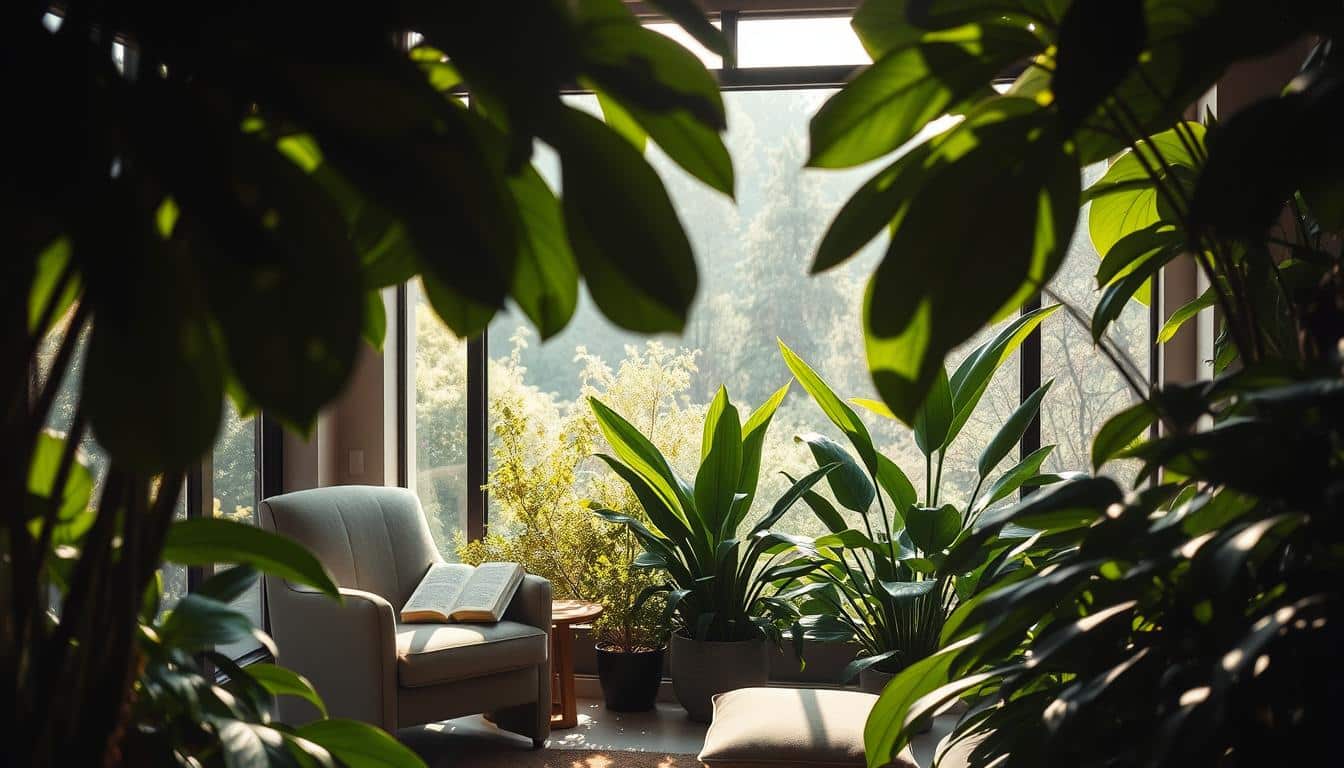In our fast-moving world, using environmental psychology in offices full of plants is key. By adding nature, companies see better moods and more work done. Studies show plants make people happier and mentally healthier. More businesses now fill their offices with plants for these reasons. This creates a peaceful work environment, boosting both mood and performance.
The Impact of Greenery on Mental Well-Being
Adding plants to different places can greatly help our mental health. Studies show that plants have strong effects on us in spaces like our homes and offices. Being around green spaces makes us feel more balanced and less anxious. This is because we have always lived close to nature.
Having plants around where we work makes us feel safe and comfortable. This makes any space more welcoming. Research has found that being near greenery not only makes us happier but also helps us relax. So, greenery does more than just look nice; it is key for feeling good overall.
Companies are working to make their workplaces healthier by using plants. Adding nature into work areas boosts how much we get done and lowers how stressed we feel. In the end, the positive effects of plants are vital for creating workspaces that truly support us.

Understanding Environmental Psychology
Environmental psychology looks at how our surroundings affect our behavior and happiness. It shows the deep link between our work environment and how we feel. By using designs with nature in mind, we can feel better and work more effectively.
For great workplaces, it’s important to think about comfort in physical, functional, and mental ways. When spaces meet these needs, people feel safe and focused. This boosts happiness. Adding plants, for example, can lead to better moods and more successful employees.
Environmental Psychology in Plant-Rich Offices
Studies link our environment to how we feel. Having plants at work can make us happier and more productive. It’s proven that green spaces in offices help with mental health.
The Science Behind Plants and Mood Enhancement
Plants have a positive effect on our moods, studies in environmental psychology show. Being around plants can make us feel calm and happy. They help us relax and reduce stress, making us more productive at work.
How Green Spaces Influence Stress Response
Green spaces are key to reducing stress. Being around nature, even indoor plants, cuts down stress hormone levels. This makes us less anxious and helps us think clearer. Workplaces with more plants provide a calmer setting, improving staff well-being.
Benefits of Incorporating Live Plants in Workspaces
Adding live plants to work areas brings many key benefits. Greenery boosts mood and makes people more productive. They make an office feel calm and help everyone work better.
Reduction of Cortisol Levels
Plants in the office reduce cortisol, a stress hormone. This makes the workplace feel more relaxing. Lower stress means happier, more productive employees.
Improvement in Focus and Concentration
Plants help employees focus and think clearer. People work better in places with lots of greenery. Adding plants can increase work satisfaction and efficiency.
Are Preserved Plants the Future for Office Spaces?
Preserved plants are becoming key in making office spaces look good and work better. They bring nature’s beauty without the hard work that real plants need. With low maintenance, these plants make office decor better.
Maintaining Aesthetic Without Upkeep
These plants start as fresh ones but go through a special process. This makes them look fresh forever without needing sunlight or water. Offices get the green look without the hassle of taking care of real plants.
- Preserved plants mimic the lush look of live plants
- Ideal for enhancing office decor with minimal effort
- Contributes to a serene and inviting work environment
Adding preserved plants to offices makes them look and feel better. Workers feel calmer and more motivated, making them work better. Businesses get to enjoy beautiful, maintenance-free plants all year.
Biophilic Design: Merging Nature with Modern Workspaces
Biophilic design brings nature closer to people in offices. This approach boosts well-being and work output. It makes the workplace healthier and uplifting. Also, it supports the values of wellness in building design.
Principles of Biophilic Design
Biophilic design includes natural shapes, materials, and ways in our buildings. Important parts are:
- Using natural light to save power and uplift spirits.
- Adding live plants and nature patterns for peace.
- Creating places with views of the outdoors.
- Choosing colors that make us feel calm and connected to nature.
Examples of Successful Biophilic Implementations
Many companies show how well biophilic design works. They’ve brought in things like:
- Moss walls for cleaner air and a cool look.
- Indoor gardens for a stress-free spot for staff.
- Green spaces with living walls and clean air systems.
These instances prove how adding nature to work areas helps employees feel better and work harder.
Improving Workplace Productivity with Greenery
Adding plants to offices makes a big difference in workplace productivity. Studies show plants can increase employee performance by up to 15%. This is because plants offer mental and physical health benefits, making the office feel better.
Boosting Employee Performance
Research shows a clear connection between greenery and better job performance. People working in spaces with lots of plants have better focus. They also do complex tasks more efficiently. The calm brought by greenery makes for better teamwork and innovation, key for boosting productivity.
Reducing Absenteeism and Enhancing Creativity
Plants in the workplace also lower absenteeism. Employees in green spaces stress less and take fewer unexpected days off. Plus, plants boost creativity, leading to more innovative thinking and problem-solving. A lively, welcoming office space builds a positive setting for mental well-being and high productivity.
Recommended Plants for Enhancing Office Environments
Choosing the right plants can make an office feel welcoming. The best plants not only look good but also boost well-being. Here are some top picks that grow well inside and are easy to care for:
- Snake Plant: This plant cleans the air and needs little light and water, perfect for busy offices.
- Pothos: It can grow in different lights, removes toxins, and adds moisture to the air.
- Preserved Ferns: They bring a natural look without needing upkeep, offering a green choice.
- Peace Lily: It has pretty white flowers and cleans the air, making it both lovely and useful.
- Spider Plant: It does well in low light and helps clean the air, making the office better.
Adding these plants can make the office nicer and more inviting. It shows how important plants are at work.
Creating a Personal Touch in Green Spaces
Making a workspace personal with green design greatly improves employee happiness. By picking their own plants or decorations, employees feel more connected to their work area. This creates a friendly space and boosts work performance.
Using preserved plants is smart for looks and easy care. Employees can show off their style and help make the office happier. Ways to make green spaces personal include:
- Choosing plants that resonate on a personal level.
- Incorporating art or photos that inspire emotional wellness.
- Designating spaces for individual plant care to build responsibility and connection.
In the end, making green areas personal not only lifts spirits but also leads to a more dedicated and productive team.
The Role of Ergonomics in Office Plant Placement
Adding plants to office spaces does more than just make them look good. It’s about placing them where they can make workspaces better and more comfortable. By putting plants in the right spots, we can help people see and reach them better. This also cuts down on distractions, making it easier for everyone to focus on their work.
Here are key points to think about for plant placement:
- Height and Size: Tall plants should go in corners or by windows, but make sure they don’t block anyone’s view.
- Reachability: Keep smaller plants on desks or shelves where people can easily touch and take care of them. This helps people feel more connected to their space.
- Light Requirements: Place plants where there’s enough natural light. This keeps them healthy and looking great.
- Safety: Be sure plants don’t block paths or emergency exits. Safety first!
By carefully choosing where to place plants, offices can be both comfortable and uplifting. Mixing plants with good design makes workplaces better. This boosts how much work gets done and how happy employees are.
Conclusion
The study of environmental psychology shows how offices with lots of plants help employees feel and perform better. Adding greenery to office spaces makes them look good and helps workers feel happier and more stable emotionally. Seeing plants around reminds people of nature, which is very important for feeling comfortable in today’s world.
Having plants around also helps people work better. Studies show a link between green spaces and higher focus, creativity, and job happiness. When companies think about their office layouts, they should think about these benefits. It’s not just a trend; it’s crucial for creating a good work environment.
By following the teachings of environmental psychology, companies can change their culture for the better. Planning offices with lots of plants is a step towards better well-being, more work done, and greener practices. This commitment makes for happier employees and a brighter future for the company.



